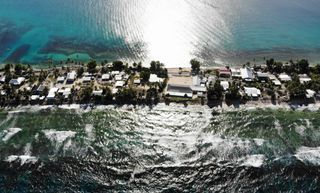
An aerial view of a strip of land between the Pacific Ocean (bottom) and lagoon in Funafuti, Tuvalu, in 2019.
(Image credit: Getty Images/Mario Tama)
About a million people live in coral atolls like those in the Maldives, Tuvalu, Kiribati, and the Marshall Islands. These islands are just a few feet in elevation, making them some of the places most at-risk from the rising seas that will result from climate change. Five uninhabited islands in the Solomon Islands have already vanished beneath the waves in the past century.
The Maldives, Kiribati, Tuvalu, and the Marshall Islands have the highest percentage of their land area at risk because they are all atolls; other countries also have low lying islands, but have more higher ground available to flee to.
So which low-lying islands will be underwater — and uninhabitable — the soonest due to climate change? As it turns out, that question is impossible to answer. Four islands illustrate why.
Mainadhoo, Huvadhoo Atoll, Maldives
First, scientists don’t have accurate elevation data for many of these far-flung islands, and even if they did, that information doesn’t predict when they will be submerged.
“Atoll islands are very dynamic places,” said Geronimo Gussmann, a researcher at the Global Climate Forum. “They shift shape, they grow in elevation. They sometimes merge very quickly.”
Related: Alarming collapse of Greenland ice shelves sparks warning of sea level rise
Sand can grow such coral-reef islands, a 2018 paper studying the island of Mainadhoo in the Maldives found. But islands get new sand from coral reefs, and global warming kills coral. At an extra 3.6 degrees Fahrenheit (2 degrees Celsius), 99% of coral reefs die. At 2.7 F (1.5 C), some corals remain.
Coral health will determine which islands can keep pace with rising tides.
Roi-Namur Island, Kwajalein Atoll, Republic of Marshall Islands
An aerial view of islands of the Kwajalein Atoll. (Image credit: Getty Images/Brandi Mueller)
Islands also don’t need to disappear to become uninhabitable. For one thing, when waves roll over low-lying islands, they contaminate fresh groundwater with salt. Higher seas mean frequent floods, and groundwater can’t recover from daily or even yearly inundation: food trees die and water must be imported.
A 2018 paper in Science Advances analyzed flooding on Roi-Namur in the Marshall Islands. It predicted that most atoll islands will have no potable water by the 2060s (if global climate goals are not met) or by the 2030s if ice sheets collapse under the “worst case scenario” for climate change. Thousands of Marshall Islanders have already emigrated.
Mundoo, Laamu Atoll, The Maldives
Many islanders are adapting, even despite devastating floods, so just defining “habitable” is challenging. “It’s poking the beehive,” Gussmann told Live Science.
Just a few blocks wide at the widest end, the island of Mundoo in the Maldives boasts a school, beautiful beaches, and a number of sports teams. It is home to less than 200 people — but even that number is surprising.
In 2004, flooding decimated Mundoo and neighboring Kalhaidhoo. The government announced that both islands would be uninhabited moving forward — “Mundoo has basically received no public sector investments,” Gussmann said — but many Mundoo families moved back. Islands without central government funding, Gussmann said, may become uninhabited first but political will can bring surprises.
Fongafale, Funafuti Atoll, Tuvalu
Urban islands receive more investment than rural ones, but they also face challenges. Tuvalu, the capital island of Fongafale, is home to about 4,000 people. By 2100, 95% of the island may flood during high tides.
To combat this, Tuvalu recently added artificial high ground on one side of the island. A long-term plan involves making the island about 50% wider, then eventually raising both sides.
But a 2022 analysis of multiple risk factors found that even these protection efforts may not keep islands habitable: declining ecosystems will hurt tourism, fisheries and islanders’ abilities to fund solutions. The scale and speed of global efforts to limit climate change will make a tangible difference. Ultimately, which islands and island communities can remain will depend in large part on how the rest of the world responds.
Stay up to date on the latest science news by signing up for our Essentials newsletter.
Meg Duff is a freelance science journalist and audio producer based in Brooklyn and the San Francisco Bay Area. She holds an M.F.A from New York University’s Arthur L. Carter Journalism Institute. Her stories have also appeared in Slate Magazine, Bedford+Bowery, the climate law podcast Damages, and Apartment Therapy.
>>> Read full article>>>
Copyright for syndicated content belongs to the linked Source : Live Science – https://www.livescience.com/planet-earth/climate-change/which-islands-will-become-uninhabitable-due-to-climate-change-first
